UPS is an uninterruptible power supply. It is usually one of the subsystems in the weak current computer room engineering, which connects the battery to the host equipment and is mainly used to provide stable and uninterrupted power supply to the equipment.
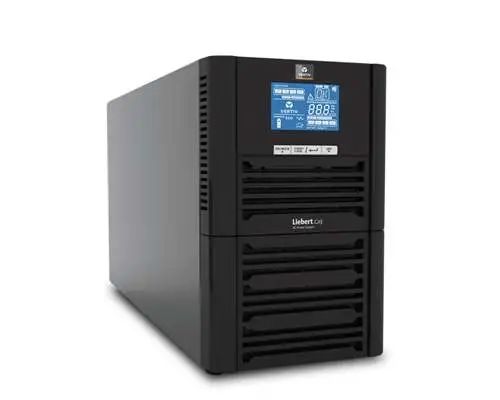
When the mains power input is normal, the UPS stabilizes the mains power and supplies it to the load for use. At this time, the UPS is an AC voltage stabilizer, and it also charges the internal battery; When the mains power is interrupted (due to an accident power outage), UPS immediately supplies 220V AC power to the load by switching the DC energy of the battery through the inverter, ensuring that the load maintains normal operation and protects the load's software and hardware from damage.
UPS equipment usually provides protection against high or low voltage. Let's take a look at the basics of UPS together.
01
The basic principle of UPS
What is UPS?
A type of energy conversion device that utilizes battery chemical energy as backup energy to continuously provide (AC) electrical energy to user equipment in the event of power grid failures such as power outages.
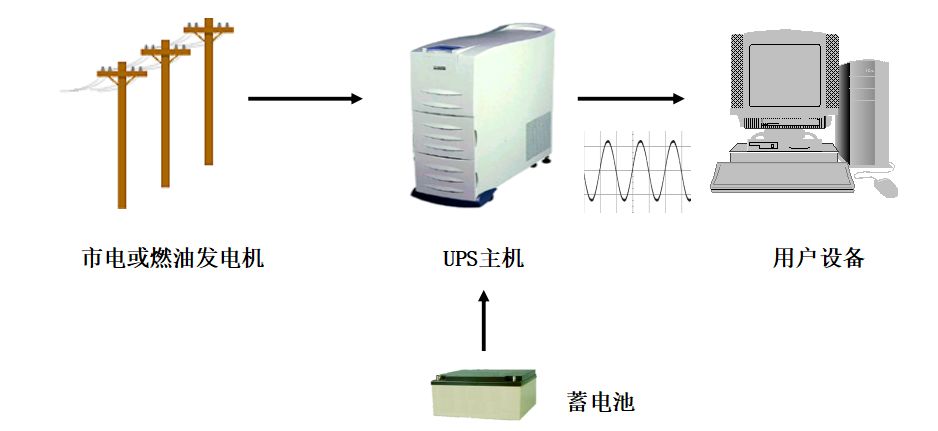
Why do we need UPS?
The electricity supply provided by the municipal power grid may seem normal, but it is unreliable: the seemingly normal electricity is actually full of dangers.

Power interruption
Data loss, communication interruption, delayed business opportunities
——Direct losses are calculated at 5000 to 100000 yuan per minute
Equipment shutdown, instrument failure, surgical interruption
——Indirect economic losses cannot be estimated
Power pollution
Transient spikes, power surges, high-voltage pulses
Causing hardware damage to servers, routers, disk arrays, and other devices
Harmonic pollution, line to line noise, frequency drift
Causing a significant increase in network transmission error rate and low data transmission speed
The four major functions of UPS
Non power outage function - solving power outage problems in the power grid
Communication voltage stabilization function - can solve the problem of severe fluctuations in network voltage
Purification function - solving the problem of power grid and power source pollution
Management function - solving communication power maintenance problems
UPS system architecture
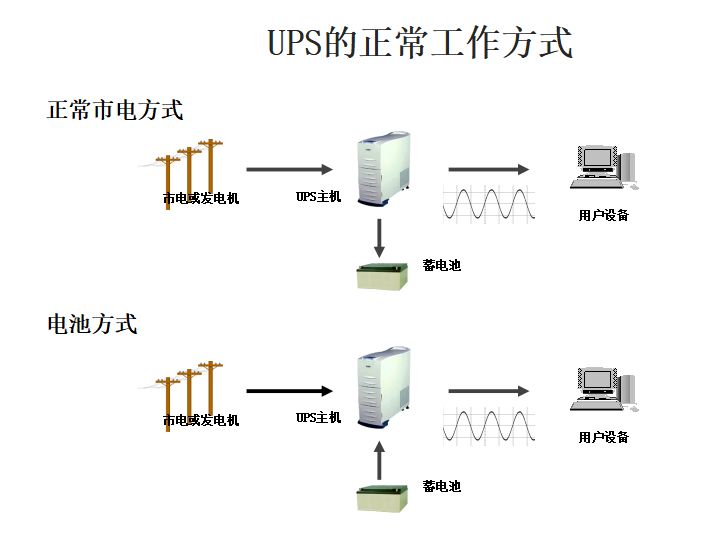
The monitoring platform is also one of the most important components of UPS

02
The main technical parameters of UPS
Input characteristics:
1. The wide input voltage range can reduce the chance of battery discharge and prolong battery life.
2. The input power factor is low, the input reactive power is high, and the harmonic current pollutes the power grid, affecting and interfering with other equipment.
3. The allowable frequency range of the main power supply.
4. Input current harmonic component. (PFC, 6/12 pulse transformer)
Output characteristics:
1. Static stability. 1% for large and 2% for small and medium-sized models.
2. Output transient characteristics. Large 5%, small and medium-sized 8%.
3. Output overload capacity. (e.g. overload 125% 5MIN; 150% 10S)
4. Output power factor. (0.8, 0.9, 1)
5. Output voltage harmonic distortion. Typical within 3%.
03
UPS related configuration and calculation
The UPS system basically consists of the following parts:
UPS host
Required functional components (such as BCB BOX, etc.)
storage battery
Supporting battery cabinets/racks, battery switches, etc
Functional options (such as lightning protection, monitoring, harmonic control, up and out lines, etc.)
Calculation required:
Calculation and selection of UPS host capacity
Calculation and selection of UPS backup battery capacity
04
UPS capacity calculation and selection
Firstly, obtain the total power consumption of the load and unify the unit to KVA.
For example, a typical personal computer has a load of about 200VA, a small server has a load of about 1500VA, and a large and medium-sized server has a load of about 3000VA.
The conversion relationship between current I (A amperes) and power consumption W (watts) and VA:
VA= I*220
VA=W/0.8 (usually considered for calculations below 20KVA is 0.7, and above 20KVA is 0.8)
Considering that UPS operates in the optimal operating state between 60-80%, it is generally recommended to divide the above results by 0.8 and magnify them again during calculation.
Then select the closest power product in the product manual and use the constant power mode calculation method
W/cell=PL/(N × six ×η)
05
Introduction to UP power supply scheme
Centralized power supply method:
Advantages: It can achieve equipotential control of network device resources and reduce transmission error rate.
Disadvantages: High initial investment and significant impact of single machine failures.
Distributed power supply method:
Advantages: Flexible scheme layout and minimal impact of faults.
Disadvantage: If the entire device cannot maintain the same ground line, it can easily cause interference.

Single machine power supply:
The simplest UPS solution
The capacity of the AC power supply system in each dispersed location is usually below 6KVA
Each AC load at each point is independently protected by a UPS for power supply
Mains power usually uses sockets nearby for input
Master slave serial "hot backup":
Suitable for small and medium-sized networks, server clusters, offices, instrumentation and other applications
Composed of UPS host, UPS slave, battery system, and power distribution system
Simple distribution design and engineering construction
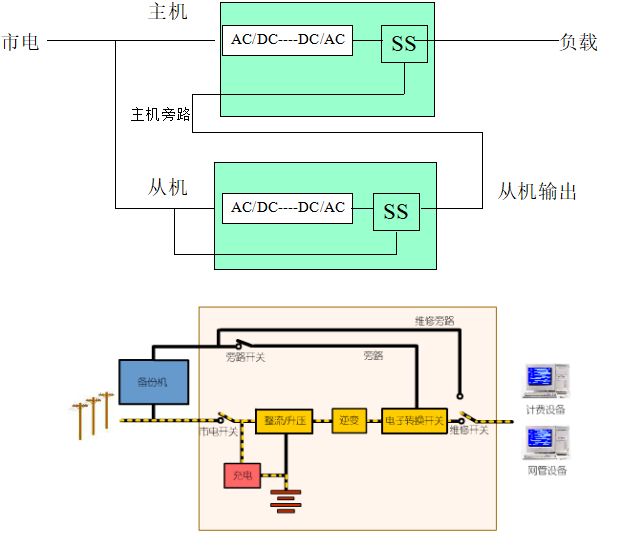
Advantages:
1. Two or even multiple UPS units are basically operating in a relatively independent and non-interference state.
2. The requirement for UPS synchronous tracking performance is relatively low.
3. Adopting different models and capacities of UPS to form a series hot backup mode.
Disadvantages:
1. The slave is in a long-term no-load operation state and has low efficiency.
2. The battery pack of the slave is in a floating charge state for a long time, and there are few opportunities for regular on load discharge maintenance, which will affect the battery life.
3. The slave must have good step load capacity.
4. Long term operation, good static bypass conversion function of the host inverter is the key without expansion function.
5. Compared to parallel redundant systems, the average time between failures is relatively low.
Module parallel power supply:
Centralized power supply for all AC loads, powered by one modular parallel UPS
Modular UPS includes: rack, parallel power module, parallel battery module, charging module, etc
Suitable for small and medium-sized networks, server clusters, offices, instrumentation and other applications
Composed of rack, UPS power module, battery module, and distribution system
The power module is configured with N+1 redundancy, reducing MTTR
Shared input, output, parallel battery system, control system
N+1 direct parallel redundancy
Suitable for applications such as medium to large networks, data centers, centralized power supply for buildings, and industrial factories and mines.
Composed of N+1 UPS, battery modules, and power distribution system that are directly connected to the machine.
System N+1 redundancy, higher reliability than single UPS.
Easy to expand and maintain.
It is the most widely used solution.
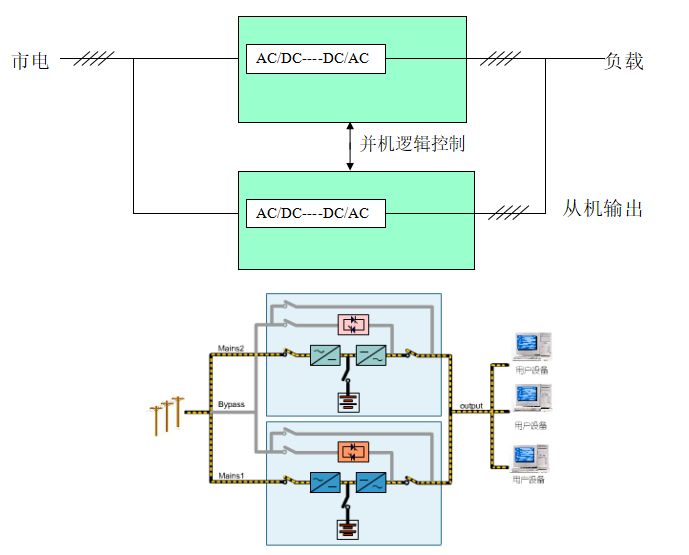
Advantages:
1. The comprehensive phase-locked synchronization technology ensures that when multiple UPS are directly connected in parallel, the load current can be evenly distributed.
2. Good scalability performance (N+1).
3. Avoiding the drawbacks of the "serial" hot backup method.
Disadvantages:
1. High requirements for synchronous phase-locked technology of the device itself.
2. High requirements for equipment manufacturing technology - output impedance close.
3. High requirements for inverter output voltage regulation performance - phase separation regulation.
4. UPS must be of the same model and capacity.
5. When multiple units are connected in parallel, the bypass also needs to increase the "current sharing inductance".
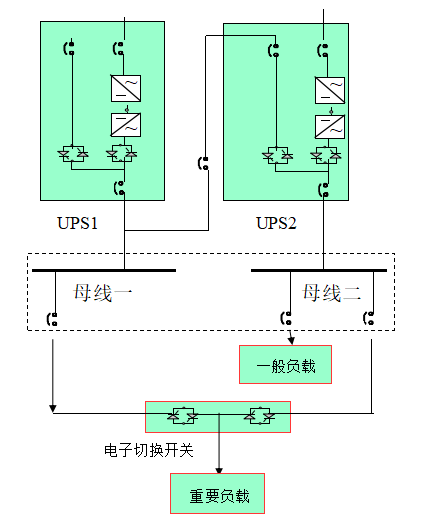
Double busbar:
Solve the bottleneck problem of single bus operation mode. Further improve system reliability. The system configuration is complex, the investment is large, and the installation and debugging requirements are high.
Source of article: official account of power attacking lions
Address: Block 2, No. 70, Yaofeng West Road, Wuzhong District, Suzhou City, Jiangsu Province
Tel: 0512-82285066
Email: sales@kegasia.com
Please contact us

WeChat official account
Copyright © SUZHOU KEG ELECTRONICS CO.,LTD All right reserved ICP NO:08120300-1 (Jiangsu) Technical support:Web design
![]()